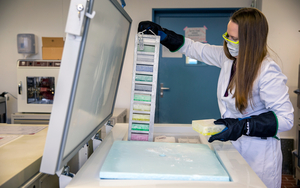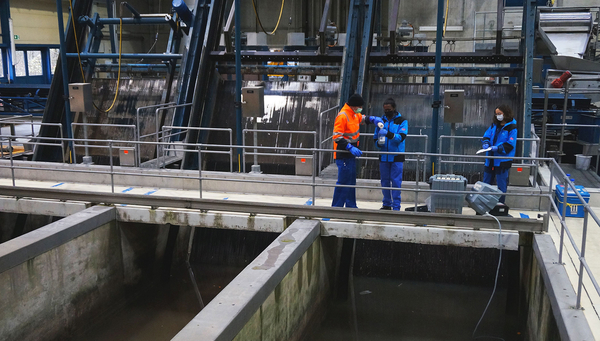News Detail
New perspectives thanks to wastewater monitoring
July 17, 2025 |
Is a new variant of the coronavirus spreading? Is there a major flu epidemic or is monkeypox on the way? Wastewater monitoring can answer such questions, at least as soon as research - constantly in a race with the pathogens - has adapted the methods for detecting traces of these pathogens in municipal wastewater. Currently, the advance of the Stratus variant, a sub-variant of Omikron, can be seen: In mid-June, it replaced its predecessor "Nimbus" in five of the six Swiss wastewater treatment plants whose wastewater is analysed using sequencing. In Chur, for example, up to 99 per cent of coronaviruses, or virus fragments, could be assigned to Stratus. In Zurich it was up to 75 per cent, in Lugano up to 80 per cent. The data is freely available on a dashboard of the ETH Group for Bioinformatics. This is interesting, but according to the World Health Organisation (WHO) it does not appear to be a cause for particular concern. XFG, the technical name for the stratus variant, does not lead to more or more severe cases of disease than other variants in circulation, writes the WHO in its risk assessment.
Drug monitoring together with the EU
The researchers, together with a team at the University of Lausanne (UNIL), were already tracking traces of drugs and medicines in wastewater well before the coronavirus pandemic. With standardised ring tests in various countries, Eawag has even made a significant contribution to establishing the wastewater-based drug monitoring of the EU Drugs Agency (EUDA). In 2017, the Federal Office of Public Health FOPH signed a cooperation agreement with the EMCDDA (European Monitoring Centre for Drugs and Drug Addiction), the predecessor of the EUDA. Today, wastewater monitoring is a pillar of European drug monitoring and the reports published annually. The associated EUDA data platform is freely accessible and also includes data from Switzerland.
Wastewater as an indicator of public health
Since 2021, wastewater analyses for viruses and for drugs and medicines have largely run in parallel, currently with samples from the six wastewater treatment plants in Basel, Chur, Geneva, Laupen, Lugano and Zurich. Priority respiratory viruses (SARS-CoV-2, influenza A and B, RSV) and 15 active pharmaceutical ingredients or their metabolites formed in the body are analysed. These include substances from cough and flu medicines, antibiotics, opioids and antidepressants. The data can be accessed on two platforms - for viruses here: https://wise.ethz.ch/ ; for pharmaceuticals and drugs here: https://www.dromedario.ch/ .
The combination of two programmes launched for different reasons now allows researchers to carry out completely new analyses: for example, it is expected that an increase in flu viruses will also be accompanied by a quantitative increase in flu drugs in wastewater. A study recently published in the journal Nature Water shows that this is largely true. However, the analyses also showed peaks in drug consumption that cannot be explained by waves of pathogens previously measured in wastewater. For example, the consumption of medicines for coughs, pain or fever that can be detected in wastewater may already indicate symptoms in the population, even if the responsible triggers are not (or not yet) known. In the case of the above-mentioned study, a subsequent comparison with data from hospitals and GPs showed that the drug peaks were possibly due to rampant rhinoviruses (cold viruses) and pertussis bacteria (whooping cough).
Early indications of new pathogens?
For Eawag Deputy Director Christian Stamm, the combined chemical and microbiological analysis of wastewater offers an opportunity for early detection of emerging diseases and stressful symptoms in society, even if it is not yet clear what to look for. In order to successfully exploit this potential of wastewater-based epidemiology, interdisciplinary collaboration between experts on the chemical and microbiological side is essential, both in research and in practice, says Stamm, adding: "In order to efficiently achieve comparable results throughout Switzerland, the standardisation of sampling, sample storage and analyses as well as joint data management also played an important role."
"Combining chemical and microbiological analyses of wastewater is a great opportunity, but requires ongoing input from research."
Christian Stamm, Deputy Director of Eawag
The measles outbreak in the canton of Vaud
The measles outbreak from January to March 2024 in western Switzerland is a good example of how young the research field of wastewater-based epidemiology still is. For a long time, it was unclear whether the measles genetic material found in wastewater really came from "wild" measles or from a vaccine strain. Therefore, an analysis method that could differentiate between wild-type RNA and vaccine RNA first had to be developed and tested. In the end, the researchers were able to subsequently detect the increase - thanks to frozen wastewater samples. However, the virus levels were low and fluctuated greatly. And from 12 February onwards, the samples no longer showed any measles RNA, although around 30 cases had been reported by the beginning of March. The researchers were unable to determine whether the infected persons were not connected to the sewage treatment plant sampled or whether the incidence was simply too low. Study published on 22 May 2025 in Environmental Science and Technology.

Deep-frozen wastewater samples can also be analysed at a later date, provided that new methods need to be researched first. (Photo: Eawag, Esther Miche)
Cover picture: Sampling during the corona epidemic at the Werdhölzli wastewater treatment plant in Zurich (Photo: Eawag, Andri Bryner)

